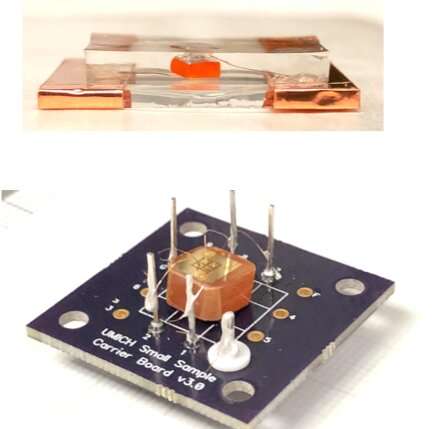New semiconductor detector shows promise for medical diagnostics and homeland security

Security officials are tasked with preventing criminals from smuggling dangerous materials into a country, and detecting nuclear substances has been difficult and costly. Now Northwestern University researchers have developed new devices based on a low-cost material to aid in the detection and identification of radioactive isotopes.
Using cesium lead bromide in the form of perovskite crystals, the research team found they were able to create highly efficient detectors in both small, portable devices for field researchers and very large detectors. The results are more than a decade in the making.
Northwestern professor Mercouri Kanatzidis, who led the research, said that in addition to being less costly than typical devices, the new method for detecting gamma rays is also highly capable at differentiating between rays of different energies. This method allows users to identify legal versus illegal gamma rays. Detectors like these are critical for national security, where they're used to detect illegal nuclear materials smuggled across borders and aid in nuclear forensics, as well as in medical diagnostics imaging.
"Using the perovskite material, we have achieved high resolution in energy detection for gamma rays using a pixelated detector design," Kanatzidis said. "This takes us a step closer to creating electronic systems for medical diagnostics and imaging, airport security and more."
The study will be published Dec. 7 in the journal Nature Photonics.
Kanatzidis is the Charles E. and Emma H. Morrison Professor of Chemistry in the Weinberg College of Arts and Sciences. He has a joint appointment with Argonne National Laboratory.
In past research, the team compared performance of the new cesium lead bromide detector to the conventional cadmium zinc telluride (CZT) detector and found it performed as well in detecting gamma rays.
But new research that improved crystal sizes and leveraged pixels rather than planar electrodes has advanced the spectral resolution well beyond that of conventional designs, from around 3.8% to 1.4%, detecting energy even from very weak sources.
Radioactive isotopes emit gamma rays that differ slightly in energy, often differing by just a few percentage points. Using the new material, users can better identify the source of gamma rays by pinpointing differences down to a few percentage points.
In addition, using even slightly impure materials typically makes detectors less efficient or nonfunctional, and producers of devices must seek ultrapure CZT to produce effective readings. To the researchers' surprise, their own material could have 5 to 10 times more impurities than CZT and still perform, making it easier and cheaper to produce. Resolution is also critical to medical imaging like SPECT scans.
Kanatzidis said there's a great deal of interest in the field, especially given the cost and safety implications of malfunctioning equipment. But progress in this realm, he said, has been slow primarily because research groups focus either on materials synthesis or on X-ray and gamma ray detectors—his group does both. Kanatzidis' lab looked at more than 60 promising compounds before landing on cesium lead bromide.
Even with advancements enabled by the new material, Kanatzidis said his work with collaborators at Northwestern and Argonne doesn't end.
"Our shelf is full of new possibilities we have yet to investigate more deeply," Kanatzidis said. "My research group is a rare combination of the engineering side and the crystal growth side of things."
Yihui He is a research assistant professor in the Kanatzidis lab and the first author of the paper.
"The new device fabrication protocols we report with our collaborators at the University of Michigan could lead to mass production of cesium lead bromide detectors in the near future," He said.
Professor Zhong He's group at the University of Michigan participated in detector characterization and analysis. Argonne scientist Duck Young Chung was a lead collaborator in the effort.
Kanatzidis and colleagues have founded a new company, Actinia, to commercialize cesium lead bromide detectors for gamma and X-ray detection and identification. These new detectors will have wide-reaching implications in medical diagnostics, homeland security and nuclear safety.
More information: CsPbBr3 perovskite detectors with 1.4% energy resolution for high-energy γ-rays, Nature Photonics (2020). DOI: 10.1038/s41566-020-00727-1 , www.nature.com/articles/s41566-020-00727-1
Journal information: Nature Photonics
Provided by Northwestern University



















